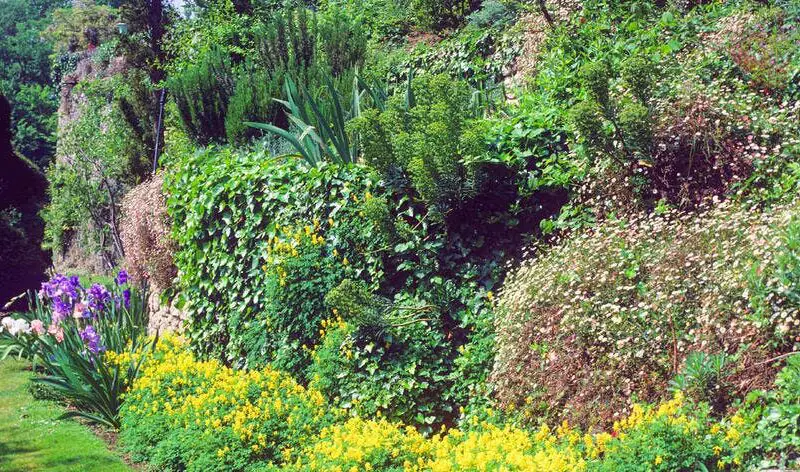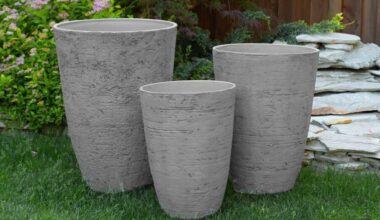If it is not easy to dress a slope or a slope, it is even more difficult to maintain them! The plants that are installed there must therefore be able to manage on their own, with a minimum of intervention by the raised bed.
This implies choosing them carefully and putting all the chances on their side at the time of planting. Here are for you 10 ideas of plants for slopes!
Contents
10 plants perfect for a slope
1. Cotoneaster horizontalis, the crawling cotoneaster
Cousin of the great cottonéaster lacteus, this shrub is a wonderful ground cover! Robust, tolerant of both sea spray and pollution, it graciously fits the slope on which it is planted, whatever the climate! Its spread out, more or less flexible, is almost crawling. Its small thick, deciduous or semi-persistent leaves, depending on the climate, take on a dark green, shiny color, while the underside is lighter.
Its white flowers bloom in spring, giving way in autumn to many vermilion fruits that persist on the shrub part of the winter for the delight of birds!
2. Hypericum calycinum, creeping St. John’s wort
This small shrub with luminous yellow flowers and green foliage forms a dense ground cover to be used for a semi-shaded slope. Its assets are numerous: St. John’s wort is very hardy, it adopts a fast growth and a long flowering period, from June to October. The flowers, useful to the foragers, are followed by small red to orange decorative fruits.
3. Shrub Sage
Maintenance-free and versatile, shrub sage often blooms generously from April/May in mild climates and are among the last to die out in November or December!
That’s 9 months of continuous flowering. Another major asset: an important choice of varieties which makes it possible to play of the color on the slope: purple tones for the flowers of Violettes de Loire for example until the bicolored flowers of the cultivar Hot lips while passing by the vermilion flowers of Royal bumble. A must, impossible to circumvent on a slope or the top of a low wall!
4. Helichrysum, the curry plant
Visually quite close to lavender with its gray foliage and its cushion-like shape, it is the sense of smell that makes the difference from afar. In hot and dry weather, the whole Helichrysum indeed exhales a strong curry scent which earned it the nickname of curry plant. Another point of dissimilarity with lavender: its pale yellow flowers that bloom in early summer!
5. Lavender
Lavender is no longer presented! Planted in groups on the top of a slope, they form in a short time vast cushions of grey, aromatic and evergreen leaves. Between July and early September, their honey flowers attract all kinds of visitors. Only disadvantage: it is necessary to prune them every year, at the end of summer, to keep them compact.
6. Lonicera nitida, the shiny hone honeysuckle
Fast-growing, shiny hone honeysuckle is the almost perfect shrub to form a low to medium cushion on a slope. Its oval foliage, fine, dark green on top and shiny, persists on the shrub all year round.
Not very demanding, robust, it adapts itself to all grounds or exposures. Its only defect is that it requires a more regular pruning (once or twice a year) than the other shrubs presented here. Left free to grow, it is rather invasive and will look like a dishevelled tree!
7. Heather (Erica)
Heather is probably the most wonderful carpet, decorative all year round. Their tiny evergreen leaves provide a green background throughout the summer, which turns into a spectacular wave of color when their countless small flowers appear along the stems, otherwise so useful to foragers. But this beauty comes at a price: heather hates waterlogged soils and even demands the acidic soil to which it has given its name (heather land).
8. Landscape roses, like “Ferdy”
In the large family of landscape roses, there is no lack of choice! They all have in common, when planted in groups on a slope, to quickly develop a luxuriant vegetation, essentially horizontal, which makes them excellent ground covers. The “Ferdy” rose is one of them.
Generous, it blooms its small roses without stopping from June to November, forming an interesting colored mass to counterbalance the preponderance of green foliage around!
9. Euphorbia characias, the euphorbia of the scrublands
The top of a south-facing slope is the best location to safely grow this shrub-like perennial (3 ft in all directions). Its assets: graphic stems with “snakeskin” patterns, dark green evergreen foliage and large panicles of yellow flowers from March to May. Beware, when she likes it, the euphorbia characias is everywhere!
10. The santolines
Grey or green, it doesn’t matter! Santolins are among the best ground covers in a mild climate, enjoying a drained soil! Their assets: a delicate, persistent and highly aromatic foliage, grey or green to which are added beautiful pompom-shaped flowers in May-June.
If we add to this their very fast growth and the ease with which they can be cut, we understand better why santolines are among the most sought-after slope plants!
How to take care of a slope
At first glance, building a slope may seem difficult. But common sense will be your best ally!
You will most likely find that there are three main parts to your slope, each with different characteristics:
- The top of the slope is the part most exposed to climatic hazards, rain, wind and sun… It is often the driest part of the earth.
- The middle of the slope is the steepest part of the slope: in fact, it is particularly vulnerable and subject to erosion. It is in fact subject to the runoff of rainwater and irrigation water, as well as possible landslides.
- Finally, the bottom of the slope tends to be wetter, and the soil is generally richer, collecting the water that flows from the top.
- These three distinct parts will be the subject of different approaches, with the aim of reconciling aesthetics and solidity, since the plantations will be designed to retain the soil and prevent the slope from collapsing.
How to plant on a slope?
To stabilize a slope, there are at least two solutions. The creation of terraces that reduce all problems related to soil erosion at once. But which adds the construction of the retaining wall and the support that goes with it: dry stone walls, canal tiles planted vertically in the ground, wooden logs, dry braided hedges…
Or vegetalization on the slope. To do this, do not hesitate to stir the soil with a pickaxe. For a “bushy” effect, it is also better to plant several individuals of the same variety next to each other, in groups of 6/7 plants. While respecting the appropriate planting spaces … In line, in staggered rows… It is a matter of estheticism.
Some people swear by the installation of a tarpaulin on the slope. Perfect if the surface is large, a little too steep, or even if the soil is too fine and too sandy. Because you can just as well be patient and let the vegetation colonize the space as you go along. To compensate for the void of the first years, a few large rocks judiciously placed will help to maintain and decorate the slope.
On the other hand, if it is really, really too steep. There is only one solution, to turn towards the plant facing, in other words the plant wall. Often as design as it is expensive if it is made by a professional of the genre.
Groundcover plants adapted to slopes
To limit the often difficult intervention on sloping areas, opt for low-maintenance plants (forget about grass that needs to be mowed), plants with a deep root system that will limit erosion, and with evergreen foliage that will not leave the soil bare in winter.
If you are considering row plantings, design them horizontally only so that they will act as a barrier to runoff. And plant a little more densely to quickly get a tighter cover.
- plants with tracing and powerful roots: St. John’s wort (Hypericium spp.), periwinkle (Vinca major and Vinca minor), daylily, iris, as well as in the Mediterranean regions, agave, yucca, opuntia, etc.
- evergreen plants : boxwood (Buxus sempervirens), creeping rosemary, creeping juniper (Juniperus horizontalis), creeping bramble, dwarf conifers …
- climbing plants diverted to crawl: ivy, wisteria, star jasmine (Trachelospermum jasminoides), honeysuckle (Lonicera nitida) …
- low flowering perennials: sedum (Sedum sp.), Iberis, houseleek (Sempervivum spp.), deltoid carnations, flugelhorn, phlox, Rosa rugosa…
You will thus be able to take advantage of a slope or sloping ground to turn it into an asset within your garden.
Summary
A slope is by definition a sloping terrain subject to the harshness of the elements where rain and wind weaken and erode the soil. If the ground remains bare, the runoff can cause major damage: floods, landslides and sometimes even landslides.
Do not hesitate to take into account the periods of flowering / leafing of the different plants: you will thus obtain a decorative slope throughout the year, with effects of shapes and colors sometimes spectacular, changing with the seasons.
Finally, since you will also be planting on the sloping part of the slope, you will have to create flat areas for each subject, without forgetting the watering basin in order to optimize the water supply.









